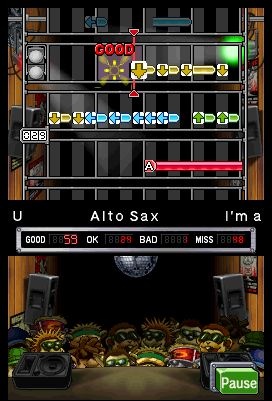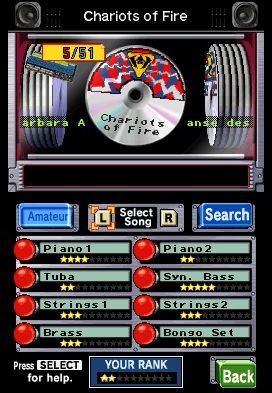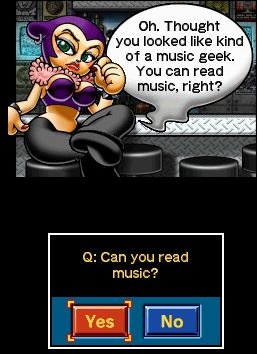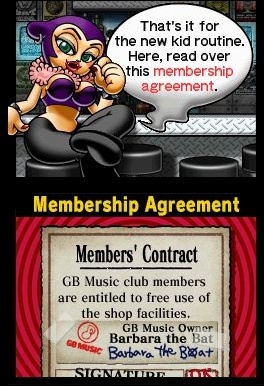UK REVIEW--Jam With the Band aims to be a one-stop-shop for music fans, combining traditional rhythm action with a music creation tool. Sadly it doesn't live up to its lofty goals and ultimately fails to make either an enjoyable experience. A simple one-button beginner mode lets newcomers get on board, but it soon becomes monotonous, requiring you to tackle frustrating difficulty levels, which keep it from being fun. The less musically inclined will find it difficult to get their head around the note layouts and studio tool, while the poor presentation gives it a dated look. If you have musical experience and a group of friends to play with, you may be able to squeeze some fun out of it, but there are far better rhythm games available for the DS.

You're introduced to Jam With the Band by the voluptuous Barbara the Bat, the owner of a low-rent rock club and shop. Since she's the owner, you have to impress her with your virtual playing skills when you take to the stage. Unfortunately, impressing her is either very dull or immensely difficult. The premise is simple enough: a marker scrolls from the left to the right of the screen in time with the music and passes over prompts corresponding to any of eight face buttons and triggers. You push the marked button at the correct time and are awarded a good, OK, bad, or miss rating, depending on how accurate your timing is. There are several difficulty levels to choose from, which vary the number of buttons you have to press. In beginner mode you have to push only a single button and keep rhythm. Its simplicity makes it accessible for beginners, but also very dull. After just a few songs you begin to suffer from the monotony of pushing a solitary button along to the music, and will want to move up to a higher difficulty level to keep things interesting. This means moving up to amateur, where you use four buttons; pro where you use eight; or master where you use all 10. However, changing the difficulty does not affect the speed of the note charts, which move far too fast. This makes it difficult to memorise the various button positions and match them up with the on-screen indicators, which whiz by at lightning speed, leaving your fingers to play catch up.
While it’s possible to become relatively comfortable with the A, B, Y, and Left button combination of amateur mode, in order to rack up some real points and progress through the career mode you need to move up to pro. The jump from four to eight buttons is massive, and co-ordinating them with the overly zealous note chart is a real challenge, particularly when multiple notes are played using the d-pad. Often multiple d-pad hits are placed in quick succession and interspersed with the face buttons, which combined with the speed at which the chart moves, makes it an exercise in frustration. This is exacerbated by the strange layout of the note chart, which is organised into one-bar sections. The marker moves from left to right across the bar and then jumps down the next one below. This means that longer notes that require you to hold a button down are cut across multiple bars, making it a real challenge to know when to let go and press the next button. There is a basic practice mode, which lets you slow down tracks by 50 percent. However, you still have the issue of notes cutting off across multiple bars, making even half-speed songs a chore.
There are 50 songs, and more are available to download for free via Wi-Fi. Strangely, once you've downloaded a song, you cannot remove it. You're limited to 50 slots, so you have to make sure you really want that copy of "Uptown Girl" before you fill the last one. The songs themselves are about as far removed from master tracks as you can get. Each one is played in general MIDI, with the vocals replaced by an instrument. This makes them sound incredibly cheesy and is akin to playing along to elevator Muzak. Worse still, the song lineup appears to have mixed the record collection of a teenybopper with that of her granddad. One moment you're playing along to Britney's "Slave 4 U," the next it's followed by a rousing rendition of Beethoven's Symphony No. 5 in MIDI strings. Not helping matters is the fact that the game often changes the "theme" of the song. For example, you may hear Blink 182's "All the Small Things" played with traditional Japanese instruments. However, nothing can prepare you for the painful aural onslaught that is a swing jazz version of "Smoke on the Water," complete with recorders and saxophones. The themed versions of songs are awful, which makes the game's constant use of them incredibly irritating.

You have two options for playing songs: quick play and the career mode dubbed Today's Gig. The career mode is sparse, serving as nothing more than a glorified mixtape. You play gigs for Barbara the Bat in her basement venue. Playing well boosts your performance rank, rated in stars. The first two stars allow you to play the songs in beginner mode, and if you do well you advance to amateur mode once you reach three. In order to progress you must continue the process all the way up to 10 stars, where you are subjected to playing songs in the nigh-on-impossible master mode. Unfortunately you can't select your own difficulty level to player through the career mode, so the only way to advance is to tackle the harder difficulties. Each time you jump into the career mode, Barbara selects a theme for the day. If you're lucky, this could mean playing piano versions of songs, but if you're unlucky, you might be subjected to the aforementioned musical horror that is the jazz theme. After playing each song, you're given a score. A score of 85 or above increases your performance rank, 70 to 84 means it stays the same, and anything below 70 decreases it. If you perform well, you're given the chance to do an encore, where you have to play a song with a different theme. If you receive a low score, or if you quit during it, your performance rank decreases. Aside from receiving compliments from Barbara, there are no real incentives to play through the encores, or indeed any of the career mode. There are no rewards or unlockables to keep your interest.
It's much easier to simply choose the song you want to perform in quick play. In career mode, you play only the vocal melody part. Quick play lets you choose from a selection of eight instruments for each song, including drums, guitars, and bass. The high difficulty level on the higher modes saps much of the fun out of playing the instruments, while beginner mode relegates you to the dullness of tapping along with one button. You also have the option of singing along to songs in Barbara's karaoke club, using the DS's built-in microphone. Lyrics scroll across the screen in traditional karaoke fashion, and you're awarded points based on how well you sing. However, there's no visual feedback as to how well you're singing, making it difficult to know if you’re racking up any points. The lack of feedback makes this option dull, though a group of friends may get a kick out of it if they sing together. On your own, there's little incentive to play it, because like the other modes, you're not rewarded for a good performance.

Fortunately, there is some fun to be had in multiplayer, where up to eight people can get together for a jam session using a single cartridge via download play. The leader of the group picks a song, while the other band members choose an instrument to play. Rather than simply hearing a quieter version of an instrument when someone messes up, you hear an incorrect note or drum hit. Although this is realistic, it isn't very fun. The lack of a quiet backing track makes it more difficult to keep in time, particularly if you have an especially bad rhythm section. However, this does make you feel like you're really playing an instrument, rather than merely playing along, so when you do nail a song with friends, you get a great feeling of accomplishment. This is helped by the fact you can't fail out, regardless of difficulty level, so no matter how bad you're playing you can keep ploughing on till you're making sweet music together.
If you want a break from the rhythm game, then you can jump into the music creation suite, where you can create your own MIDI masterpieces using the basic or advanced studio. As its name implies, the basic studio is a very simple way to make songs. You can input notes by humming them into the microphone or by playing them on the keyboard. A click track lets you keep time, while a scrolling musical score keeps track of the notes. Neither method is great for making songs. Humming your tune in results in some awful creations because the game isn't accurate at identifying what notes you're singing. The keyboard input fares a little better but is restricted by the DS touch screen. Because it can sense only one touch at a time, you can't play in chords. You can also see only one octave at a time, and changing it requires you to push an onscreen button away from the keyboard, which interferes with your playing. Once you've played your notes, you can select from a range of premade backing tracks to set to it. The game automatically matches the backing track to what key your notes are in and changes it accordingly. Like all the other songs, the track is played in MIDI, so it doesn't sound great, but the game does a good job of matching your playing to the correct backing track key.
The advanced studio lets you program in notes directly using a musical score. You can pick up to eight instruments to play on each track and choose their sound from anything in the general MIDI library. The editing features are limited, but can be useful for jotting down ideas when out and about. To create a song you drag a note value from the top of the screen onto the score, building up your composition. You can copy and paste sections, and there is one stage of undo should you make a mistake. However, there is no way to loop a section and listen to it, so you constantly have to hit rewind and play while you're testing new ideas. You're also restricted to 120 bars of music, and there is no indication as to how long your song is in minutes on the editing screen. You can solo a track while you're listening to it, but only one track at time, so you can't see how well your bass line is mixing with the drums without listening to all the instruments at once. The final problem is that there is no way to change the volume of individual instruments, so you can't layer your instruments in the mix. As a simple tool for getting your spur-of-the-moment ideas down, the studio works. However, advanced users looking for more flexibility will be disappointed with the lack of features, while beginners will be perplexed by the musical score input. Sharing options for your music are also limited. You can upload your track to the central list of downloadable songs, but only if it is a cover of an existing composition, which must be matched up in the Compact Disc Database for identification. If you upload an original creation, it will not be approved.

Jam With the Band is a poor rhythm game. It's confusing and overly fast note chart layout makes it difficult to play, while the massive jump in difficulty between the amateur and pro modes means you'll have a hard time advancing through the lacklustre career mode. The basic studio is too restrictive, the advanced studio lacks the power to make it anything more than a notepad, and the perplexing restrictions placed on music downloads and uploads only serve to annoy. The presentation also leaves a lot to be desired, with blocky graphics, poor animation, and garish colours plastered over every screen. While you can have fun playing the game with some friends, the dull single-button beginner mode and the dedication required to learn the complex controls on higher difficulty levels makes the boring single-player not worth the effort. Though it held promise, Jam With the Band is a prime example of how to make an inaccessible and boring game. There are plenty of good games in the rhythm genre on the DS, but this certainly isn't one of them.